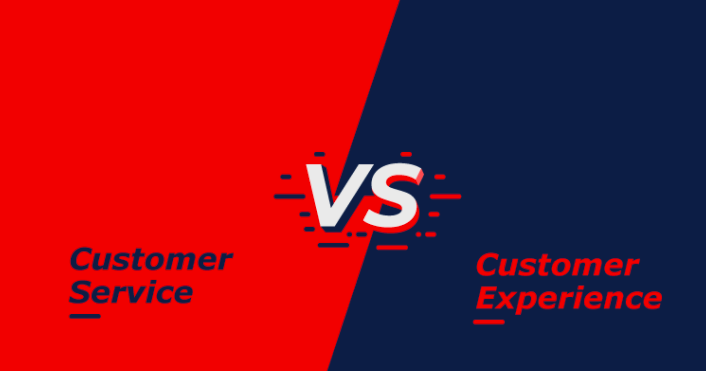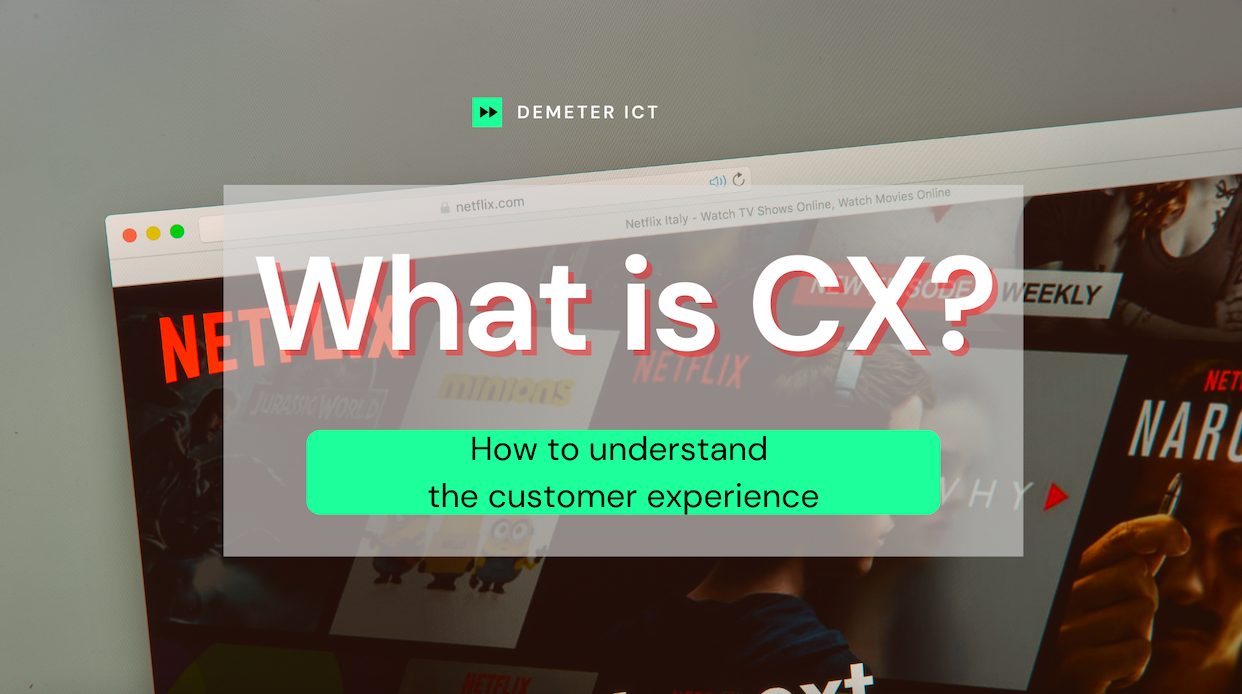What is customer experience? What is a good customer experience? Why is the customer experience so important? All your CX questions, answered.
Customers have come to expect more out of companies, but who can blame them? We’ve all had customer experiences that range from outstanding to infuriating. It’s put more pressure on companies to find a balance between the experience they want to offer and limited internal resources and other priorities—especially when the well-known customer-centric companies are the ones reaping the rewards.
In this article, we’ll explore:
- What is CX?
- Top trends in CX
- Why is customer experience so important
- What is a good CX?
- CX management
- Improving your CX strategy
- Measuring CX
What is meant by customer experience?
Customer experience (CX) is everything related to a business that affects a customer’s perception and feelings about it.
“Customer experience is the sum of all the interactions that a customer has with an organization over the life of the relationship with that company or with that brand”
Annette Franz, founder and CEO of CX Journey
Customer experience (CX) focuses on the relationship between a business and its customers. It includes every interaction, no matter how brief and even if it doesn’t result in a purchase.
Whether it’s a call to a contact center, exposure to an ad, or even something as mundane as the payment of a bill, every exchange between customers and businesses builds (or damages) the relationship.
Most important, it’s how customers view those experiences in aggregate that matters.
“Customer experience involves every way a customer interacts with a company, at all stages of the customer journey.”
Dave Dyson, Sr. Customer Service Evangelist, Zendesk
“Customer experience is how a customer feels about the sum of their interactions with a business,” said Dave Dyson, Sr. Customer Service Evangelist, Zendesk. “It involves every way a customer interacts with a company, at all stages of the customer journey—including the marketing materials they see before they become a customer, the sales experience, the quality of the product or service itself, and the customer service they receive post-purchase.”
What makes up the customer experience?
Nowadays customers have more ways to interact with businesses and experience them than ever before. This includes:
- Traditional brick-and-mortar stores visits
- Mobile apps
- Social media
- Web/SMS chat
- Support forums
- Creative endeavors from marketing
- Even devices connected to the Internet of Things
In tackling the complexity of the customer experience, from interaction to interaction, and arriving at a definition of what the customer experience is, it can be helpful to break it down into its basic components.

- Culture, strategy, and processes
When the International Data Corporation surveyed customer service organizations about who led efforts to deliver superior customer experiences, over 72 percent of respondents replied that the strategy was led by either the CEO or other senior executives.
In other words, the people at the top need to use their influence and power to ensure that their companies focus on providing a consistent customer experience throughout their marketing, sales cycle, and especially in their customer service.
Leadership must set the tone and drive its customer experience values throughout the organization, being willing to break down silos and develop strategies and processes, customer experience and beyond, that realize the company’s goals.
Setting priorities within the company and balancing customer experience with other departmental resourcing needs also falls on leadership. “CX strategy and values that are not backed with resources won’t get very far,” said Dyson.
- Products and services
These must meet customer needs, demands, and expectations; the companies with the best customer experience strategies use their knowledge and culture to anticipate customer experience needs before customers ask for help. An experience may not always be tangible but the elements that create it are.
“A product that meets customer needs and expectations will require less post-sale support than one that does not,” said Dyson.
- People
Customer service agents, partners, suppliers—all play essential roles in delivering a consistent customer experience. That means understanding the company’s strategy and having the training and morale to define and implement an impactful customer experience successfully.
It also means creating a great employee experience to make it easy for employees to meet customers’ needs and expectations.
“Training, tools, policies, processes, and culture all need to serve people—the customers and employees who serve them—not the other way around,” said Dyson. “How you measure success, whether you encourage employees to collaborate or compete, what opportunities you provide for them to grow, how empowered they are to make decisions to help the customer—all these things can affect the employee experience, which ultimately affects the customer experience.”
- Information
This can be business-to-customer, employee-to-employee, and from partners-to-customers—content, data, and analysis.
Knowledge management resources, both external and internal, play an important role in improving organizational efficiency and providing customers with self-service options. If customers can respond to your marketing collateral, be aware that’s included as well.
- Customer touchpoints and channels
This includes all the touchpoints and channels through which a customer experiences an organization—phone, email, text, chat, ads, your website, or even a third-party review site, like Yelp.
- Technology
By definition, the modern customer experience environment relies on technology to drive service, such as customer service software.
What is the difference between customer experience and customer service?

The difference between customer service and customer experience is that customer service is one factor in the customer journey while customer experience is the sum of all a customer’s interactions with the brand.
In other words, customer service is one piece of the customer experience puzzle.
“Customer service is what happens when the experience breaks down. So if we get everything right, if we have executed the experience flawlessly, or if we’ve done a great job with designing and executing on the experience, then we don’t need customer service. Because there’s not an issue with the product. The billing is accurate, it’s thorough.”
Annette Franz, founder and CEO of CX Journey
Good customer service is vital to your company’s overall customer experience. Agents are often the first (and only) human voice customers hear, especially when they reach out with an issue.
Top trends in CX
All year every year at Zendesk, some of the world’s sharpest analysts are doing research and then painstakingly interpreting it to illuminate the coming year’s biggest trends in the customer experience. A few key points from Customer Experience Trends Report 2021:
- Customers adopted new habits during the pandemic, and most plan to keep them : For instance, 31% of customers bought from a new company in 2020 and 84% plan to keep buying from them
- The use of messaging, already high, has skyrocketed : More customers chose embedded messaging (45%) to contact customer support than those who chose text or SMS (20%)
- When it comes to going digital—adapt or get left in the dust : 50% of company leaders say digital adoption has accelerated by 1 to 3 years
Why is customer experience so important?
Customer experience is important because it impacts a business’ bottom line.
How customers feel about your brand is tied to customer retention, lifetime value, and brand loyalty—and 52 percent of customers report going out of their way to buy from brands they’re loyal to, according to Zendesk’s Customer Experience Trends Report, 2020.
Attracting and retaining customers in an ultra-competitive business environment is no small feat, and companies that ignore the importance of providing a seamless, effective customer experience can end up losing out to rivals who understand that it’s the customer who defines good service.
This means even one experience that doesn’t live up to customer expectations could have drastic results on brand reputability and that reduced room for error is exaggerated by the ease of switching in the web 2.0 era. If you don’t like a product, or the way a company interacts with you, finding an alternative is as easy as a Google search.
In fact, half of customers say they would switch to a competitor after just one bad experience, according to Zendesk’s Trends Report. In the case of more than one bad experience, that number snowballs to 80 percent.
“A good customer experience drives competitive advantage. Customers can always choose to go elsewhere,” said Dyson. “If you’re having trouble and can’t reach customer support, you’re going to get frustrated, perceive that as a bad experience, and you might leave. Businesses that provide good experiences set expectations for what a customer experience should be at similar businesses.”
50% of customers will switch to a competitor after one bad experience. In the case of more than one bad experience, that number snowballs to 80%.
Due to this developing market saturation, many companies are realizing customer experience is their best chance to stand out from competitors. In other words, if a good product and competitive pricing are no longer enough to produce loyalty, then a personalized experience will have to be your differentiator.
What is a good customer experience?
A good customer experience is one that makes it easy for a customer to do business with you, according to Dyson.
“A great customer experience makes it effortless for customers to accomplish their goals for what they want to use your product or service for,” he said. “Customer loyalty is less about big “wow” moments and more about being dependable and making things easy for customers.”
A positive customer experience might include:
- Marketing setting realistic expectations about the product or service
- Intuitive product design
- Easy-to-access self-help resources
- Proactive messaging around known issues
- Sales being transparent about pricing
- Always-available live customer support with short waits
What’s important is that all these teams are working together to create a seamless, consistent experience for the customer.
Since every customer interaction is usually handled by a separate department, it may seem like having satisfactory metrics within each department would be enough to create a great customer experience. However, the tricky part about customer experience is that the consumer does not experience their relationship with your company as a series of smaller interactions, but rather will remember it as one ongoing interaction.
This can create problems for organizations in which various departments are siloed and do not communicate in between each other. Silos can result in customers having to repeat information, fill out forms multiple times, or just a customer journey that drags on longer than needed.
For instance, agents should be able to easily access context like what items are in a customer’s shopping cart or what outbound email promotions they’ve opened, even if the marketing team is directly responsible for that information. Likewise, a marketing team should have insight into past support interactions so they can send customers more targeted emails.
Being aware of customer experience from an end-to-end viewpoint and making sure customers’ needs are at the center of attention every step of the way is key for creating a good customer experience.

Customer experience management
Customer experience management is “the practice of designing and reacting to customer interactions to meet or exceed their expectations, leading to greater customer satisfaction, loyalty, and advocacy,” according to Gartner.
Companies that are unable to successfully manage the customer experience are often taking a fragmented approach; that is, they’re looking at the different factors driving customer experience and figuring out how each one can be improved. While they’re doing so, they aren’t giving due consideration to how each factor influences the others.
That approach upholds the chaos that causes unsuccessful customer experience management.
By taking a more organizational and holistic approach to a customer experience strategy, it leads to more customer satisfaction and loyalty. Here are some areas to keep in mind when building your customer experience management strategy:
- Marketing
Marketing’s role in the customer experience might be the most dynamic; it needs to be constantly adjusting to match the shifting needs of customers.
Marketers are often responsible for making the first impression on a prospect through ads, outbound campaigns, and word-of-mouth. Their influence continues through public communications, social media marketing, and creating a brand presence. The data gathered through all of these customer touchpoints can help you create more personalized customer experiences, which in turn creates more loyal customers.
- Sales
Sales organizations are responsible for solidifying the expectations of becoming and being a customer. Outside of quick retail experiences, the sales process is often very attentive to the customer journey and meeting the needs of their prospects.
This provides valuable insights concerning what customers are looking for (be it specific features, follow-ups, support requirements, etc.) which in turn can influence the efforts in other parts of the business. When your customer experience is in-sync, sales can be more enabled to close repeat purchases and reduce customer churn rates.
- Product
The goods and services provided by a company and the customer experience are closely linked; many customers will pay more for an experience than the product they’re receiving (think of the differences between high-class dining and fast-casual fare).
Beyond the immediate experience, there are details like reliability, affordability, user experience (UX), general ease of use, and a product’s life cycle that all tie into the customer experience. The experience provided by the product is the primary contributor to a business’s reputation, which in turn impacts every other part of the customer experience.
- Customer service
After a sale, customer service is often the primary department that interacts with the customer.
Support agents are in a position to collect real-time feedback on the customer experience: they can see how customers interact with the product, how (and if) expectations are being met, and how the customer base is changing. Feedback is the most critical part of the customer experience; businesses can’t effectively evolve without it.
A CRM platform like Zendesk’s Sunshine can help connect customer data from all these teams and areas of the business together to streamline management.
7 ways to improve your customer experience strategy
As competition heats up and economic uncertainty is a given, one thing is for sure: a good customer experience can help drive the success of a business. But loyalty isn’t given—it’s earned. And without the right strategy, it’s easily lost.
The good news is that customer experience can be improved. And it starts by putting the customer at the center of your strategy. Here are 7 tips:
1. Create feedback loops
Customer feedback provides insight into customers’ expectations, and how they might change over time with changes in your industry. It can also tell you where customers are getting stuck and confirm what’s working well.
The key is to acknowledge the feedback and do your best to act on it. “It’s important to create a feedback loop with customers and act on what they tell you,” said Dyson. “This builds trust and ensures it’s not just lip service.”
Dyson also recommends creating an internal employee feedback loop. Agents can help aggregate customer feedback and provide insight into what’s making it challenging for them to deliver great service, such as policies or processes that don’t suit customer needs or friction between siloed teams that’s leading to slow resolution of customer issues.
2. Build an omnichannel experience
When you develop an omnichannel CX strategy, you aren’t just meeting customers where they are—that’s table stakes.
Omnichannel means going a step further and providing a consistent communications journey for your customer, one where the conversation history and context travels with them from channel to channel.
Context—about who your customer is, what outbound emails they’ve opened, what’s sitting in their shopping cart, or what they’ve talked to you about in the past—is crucial for delivering a good experience across channels.
3. Create a content management strategy
Customers would often rather solve issues on their own than reach out to a live agent. You can help them help themselves with data-driven content.
Usually, it’s in the form of help articles or chatbots that quickly point customers in the right direction. Ensuring that your content is accurate and up-to-date is crucial; an unhelpful article translates into a bad experience.
4. Deliver personalization
According to the 2020 Customer Experience Trends Report, 76 percent of customers expect personalization using data.
This might include engagement over their preferred contact method, account type or status, product recommendations based on purchase or search history, or some kind of personalized online experience.
Tailoring support efforts towards customer personas can go a long way, especially in the case of customer experience. Gathering context about who they are (they’re preferences, personalities, habits, etc.) can help agents better target their support that leads to faster resolutions. It may be helpful to conduct UX research on your business’s support initiatives to figure out ways to make interactions more personalized.
5. Empower customers through AI
Gartner estimates that by 2022, 72 percent of customer interactions will involve an emerging technology such as machine-learning applications, chatbots, or mobile messaging.
AI-powered chatbots and virtual customer assistants are handy for quick, repetitive tasks. But when they reach their limits on providing capable customer support, humans need to be there to help their customers.
6.Deliver proactive experiences
Simply reacting to customers’ needs is no longer enough to stand out. When businesses are proactive—anticipating customers’ needs and getting ahead of a problem before it escalates or even happens—they can create a unique experience that feels personal.
Proactive support for me is about getting ahead of technical issues, breakdowns, issues that you have identified — and then reaching out to customers to let them know: Hey, here’s what’s going on and here’s what we’re doing about itAnnette Franz, founder and CEO of CX Journey
An e-commerce company might deploy a chatbot on its checkout page to answer customers’ questions before they abandon their cart. Or, an internet company might send a text to let customers know about an upcoming outage.
7. Use data and analytics
The stories found in the data about your customers and your support agents will clue you into many things: the efficiency of the support organization, general satisfaction with the interactions, behavioral trends amongst your customers, and lots more.
Refining processes with the customer experience in mind starts with understanding what the data is saying.

How to measure customer experience
“There’s no single, magic number to measure customer experience,” said Dyson. “You have to look at all the little pieces of the elephant. Customer experience is hard to measure as a whole so the more data you have, the better.”
Here a few places to start:
- Send customers satisfaction surveys
These give you insight into things like customer satisfaction score (CSAT) and Net Promoter Score (NPS).
- Measure customer effort score (CES)
This tells you how easy a customer thought it was to get a resolution to a recent contact.
- Analyze churn rates, expansion rates, and customer lifetime value
“You can take a look at churn and expansion amongst different cohorts and compare them, such as those who interacted with your support team and those who didn’t,” said Dyson. “If those who contacted support are staying longer, you know your support team is creating a good experience.”
- A/B test new CX efforts
For example, when integrating your customer support tool with your marketing automation system, you can A/B test emails to targeted customer segments.
- Use your community forum as a virtual focus group
Community forum discussions around pain points, feature requests, or how customers are using your product or service can provide insight into how customers feel about their experience with your business.
- Look at customer service data like ticket reopen rate and time-to-resolution
“Looking at how long customers have to wait before they get an answer is one way to measure customer experience. No one likes to wait when they need help,” said Dyson.
- Talk to customer-facing staff
“Beyond the numbers, it can be equally as helpful to ask customer-facing staff about what customers are telling them,” said Dyson. For instance, customer support might have insight about pain points they can share with the product team. “It’s also key to ask agents if they’re having any difficulties. If they are, chances are customers are too. When you make your agents’ jobs easier, they can provide a better customer experience.”
Customer experience matters
Investing in good customer experience is important for any company, no matter how big or small. After all, your success depends on your ability to keep and attract loyal customers. And failing to put your customers first can send them straight to your competitor.
Want a really easy way to immediately improve customer experience? Consult us for your CX Transformation and Zendesk Trial today.
Contact Us: Demeter ICT Company Limited, No.1 Zendesk Authorized Solution Provider in Thailand and APAC No.1 Zendesk Authorized Solution Provider in Thailand and APAC. [ Demeter ICT ] – Our specializations are “CX Design”, “Consulting,” “Implementation“, “System Integration” and “Training” for Zendesk. We help clients analyse, design workflows, and build a good CX.
LINE OFFICIAL

-
For additional information and special promotion call now!
Tel. (+66) 2 030 0066 (TH/EN)
Tel. (+86) 14778852841 (CH) - Facebook Page : @demeterict
- support@dmit.co.th






